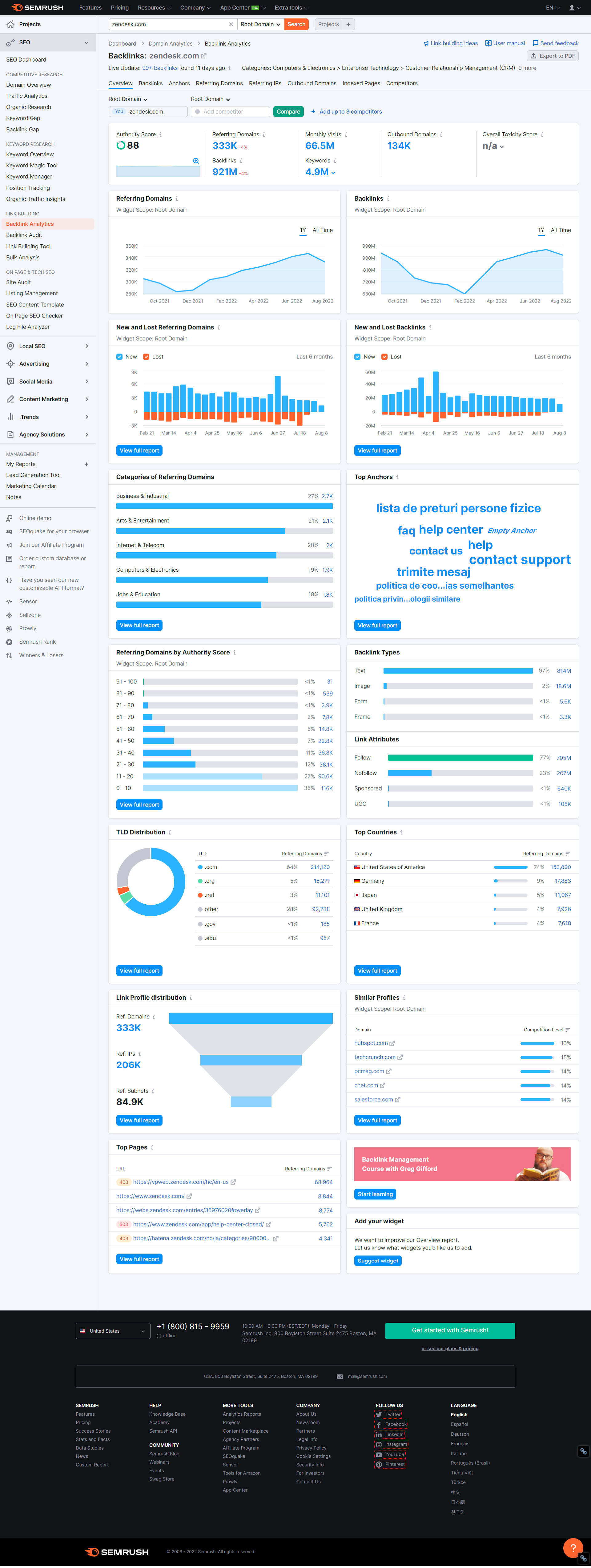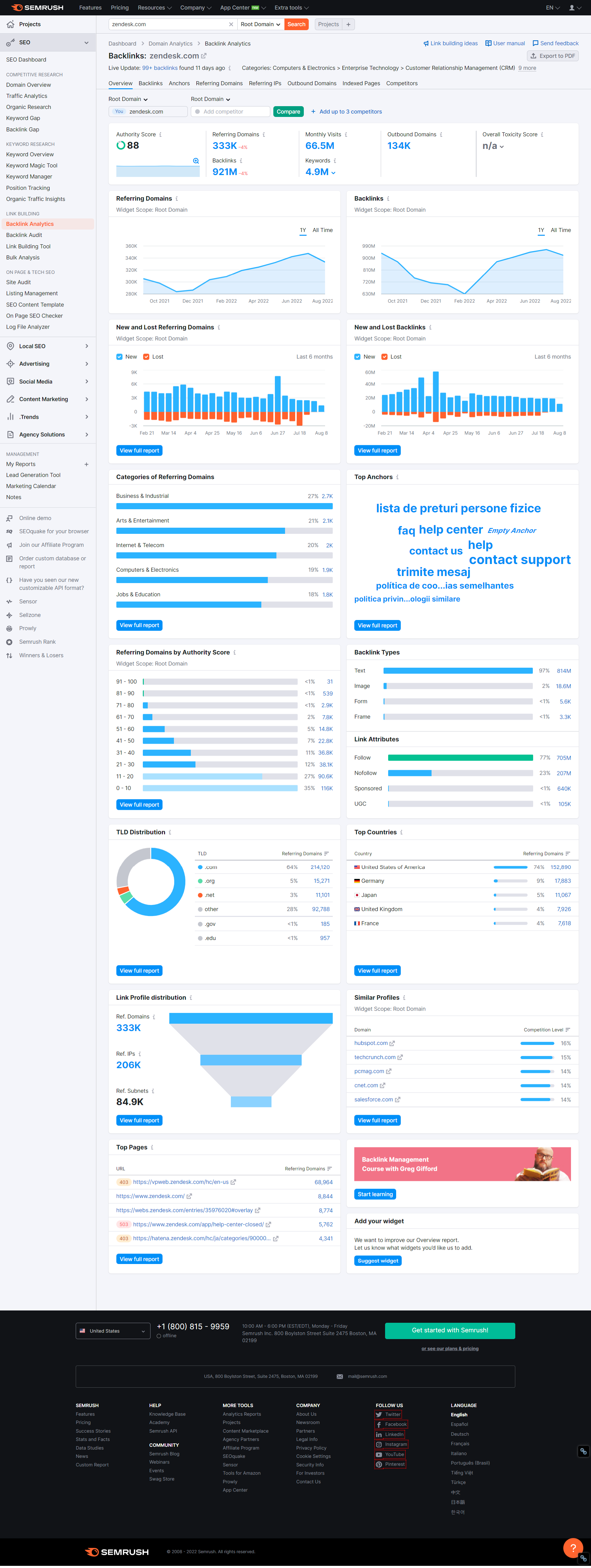Do you want to know where Semrush gets its data from?
Semrush uses its trusted data providers and machine learning algorithms to present the data in its databases.
The SEMrush database includes 21.1 billion keyword data and 808 million domain data for 190 regions and countries. SEMrush uses third-party data for keyword and search engine analytics.
Semrush provides real data for over 500 million popular keywords that online users actively use to search on Google. The data collected by Semrush helps marketers make decisions on their marketing campaigns for SEO, social media, and PPC.
With SEMrush, you can easily view any site’s backlink profile to analyze your own or your competitor’s site.
In this guide, I will take a look at Semrush in detail and find out how Semrush gets all the data that we see when we login in Semrush dashboard.
What is Semrush & How Does It Work
Semrush is one of the most popular SEO tools built to help companies get accurate marketing insights and handle their online visibility.
SEMrush was started in 2008 to make online competition fair and transparent. Its mission is to create a platform where everyone can get the opportunity to operate equally. More than 7 million customers rely on Semrush to collect data to improve their business.
With the help of Semrush, you can conduct:
Keyword research
Semrush uses a research-based approach to find the optimal keywords. It has the biggest keyword database in the world, comprising over 21.1 billion keywords indexed to date. When you use Semrush, it pulls the data to understand how the competitor’s sites perform.
Google Ad optimization
If you are running Google Ads campaigns, you can optimize your PPC strategy using Semrush tools. Find your competitors in Google Shopping and uncover their product pricing strategy.
Competitor analysis
Researching your competition is important in any marketing strategy. Go to your Semrush dashboard and click on the “Organic Research” tab on the left-hand side of the screen. Type in your website’s domain and press enter.
By clicking on the “Competitors” tab, you’ll see a list of websites with the same keywords as your domain. You can consider them your main competitors for online traffic.
By using this advanced tool, you can also recognize the recent trends and patterns in your specific niche and audit your site. You can use SEMrush Site Audit to keep your SEO strategy up to date.
SEMrush offers several service options to users. Each plan consists of a set amount of features and functions and costs a predetermined monthly price. You can also invest in an annual program.
How Does Semrush Pull Its Data
Let’s see from which sources Semrush is getting its data…
Semrush Pulls Data In Two Ways
- The first way is the search bar. By typing the website address in the search bar, you can pull a report on the domain and get a list of the keyword selection. Semrush researches your competitor’s keywords and suggests you an ideal way to compete with them.
- The second way Semrush pulls data is through the construction of projects. Through these projects, Semrush collects data from external databases.
Where does Semrush Get Its Data From
Semrush gets its data from third-party providers and overlays the acquired results with historical clickstream data from reliable sources. It forwards the resulting data to a computing cluster and gets a computational model. By applying this model, Semrush gets the volumes for billions of keywords.
1. Website traffic analytics
With Semrush, you can access accurate data from more than 200 million internet users from around 190 regions and countries.
SEMrush Market Explorer and Semrush Traffic Analytics are two tools offered to SEMrush customers that give you access to hugely valuable data about any website’s mobile and desktop traffic.
Insights drawn from the Semrush database about your competitors can help you earn more traffic by out-competing them. By analyzing the number of visits to your site, Semrush can measure your website’s online traffic. This data is provided to you from a unique aggregated database.

2. Search engine data
Semrush can be used to get accurate search engine data, including domain information, keyword rankings, and backlinks pointing to those domains.
You can use the Position tracking tool to track your keywords positions on Baidu and Google.
The Traffic Analytics tool can give you an estimate of how much traffic a website receives from search engines such as DuckDuckGo, Bing, Google, Baidu, Yandex, etc., depending on the filters you apply (Location, Devices, Date).
3. Search engine data collection
Semrush uses third-party data for keyword and search engine analytics. It provides users with accurate data for over 500 million of the trending keywords that online users search on Google.
The Semrush API allows you to export raw data without using the standard website interface. You can even automate the process to get accurate data efficiently and quickly.
But it doesn’t matter how much volume the keyword brings in as it’s a guesstimate and might change next year or month based on new trends.
4. Backlink data
With SEMrush, you can view the backlink profile of any website. This can help you analyze your own or your competitor’s site.
Semrush database has trillions of backlinks across the web that can provide a clear picture of any niche in terms of its competitiveness. It singles out new SEO opportunities for website owners by using its backlink crawler that scans for new links in its database.
Semrush Backlink Analytics gives you the ability to analyze your competitors’ backlink profiles. Semrush backlink crawler combs 25 billion web pages daily and adds new links to its database to collect backlinks.

5. Online advertising data
Semrush is one of the best tools for analyzing and researching Google Ads. It has an extensive database that gives you insights about advertisers and their paid advertising campaigns through Google.
SEMrush can give marketers insights into how much it costs businesses to run the ads. Track your visibility against key competitors in paid search and gain insights from SERP analysis of Shopping ads, Featured snippets, and more.

6. Social media data
Semrush Social Media Analytics tool lets you see your internal analytic metrics for your LinkedIn, Facebook, and Instagram channels.
It collects public information such as the number of followers, likes, retweets, video views, hashtags, and comments from the pages you choose to track. Then, it organizes the data to present reports about each social profile’s engagement, growth rates, and audience.
Semrush uses the public APIs of popular social media networks to attain this information. It never uses or collects any personal data without consent.
By linking your social media accounts with Semrush, you can track your statistics, such as followers, engagement, development, etc. The best thing about SEMrush is that you can analyze a competitor’s website and get an idea of how active they are on social media.
FAQs:
How does Semrush get organic traffic data?
Semrush utilizes a research-based approach to find the top-ranking keywords. It pulls your data from Google Analytics, including metrics like typical session period, bounce rate, etc. It reveals which keywords drive more traffic from Google and other search engines. Semrush calculates each word’s financial value and allows you to visualize your competitors landing pages for each keyword. Semrush can also detect new competitors on the SERPs.
Where does SEMRush get its keyword data from?
Semrush gets its keyword data from various sources, including competitor analysis tools, paid search engines, and social media platforms. It has the biggest keyword database on the market. By evaluating different domain rankings and the most commonly used keywords, Semrush decides what selection of keywords can increase the visibility of your site.
How Does Semrush Collect Data?
Semrush uses trusted third-party data providers to get keyword data from Google’s search results pages. It has its own backlink crawler for its backlinks database that automatically searches millions of web pages. For social media analysis, it crawls the application programming interfaces and the public APIs to gather information about comments, likes, and impressions. Through a combination of information from trusted sources such as Facebook and Google, its data-crawling algorithms, and outsourcing to third-party data providers, SEMrush collects extensive data from the web.
Is Semrush keyword database useful for you?
Semrush keyword database is one of the most accurate sources compared to other SEO tools. As of June 2022, the Semrush keyword database has 21.1 Billion keywords. It is updated weekly and provides comprehensive information on organic traffic insights, keywords, and search position data that can be useful for any online business.
With powerful features and tools like the Visibility score, it stands unique from other online tools. It can help you build backlinks, target keywords, develop optimal content marketing strategies and track your site’s performance.
It also has a good set of PPC and Paid Ads modules. You can take your paid and organic search ranking to the top level using Semrush SEO digital marketing tool. Semrush also comes with a 30 Days Free Trial or seven days money-back guarantee. So you can try the Semrush free trial to know whether it caters to your needs or not!





